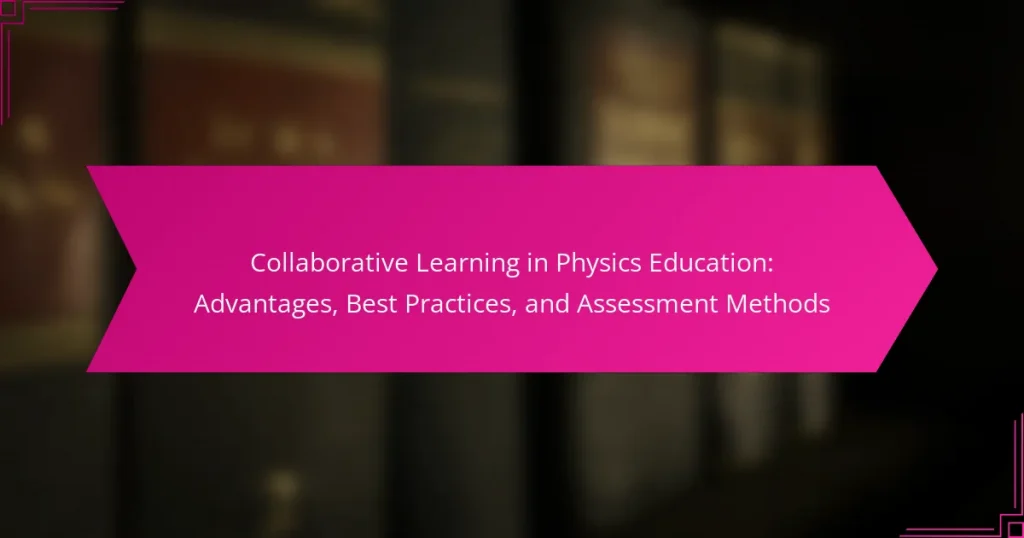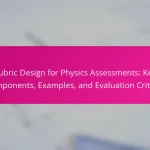Collaborative learning in physics education is an instructional method where students work together to solve problems and grasp concepts, fostering active engagement and communication. This approach enhances critical thinking and promotes retention of physics knowledge, as supported by research highlighting its effectiveness in improving student motivation and achievement. Best practices for implementing collaborative learning include structured group activities, clear objectives, and diverse group compositions, which facilitate deeper understanding. Regular feedback and the use of technology further enhance collaboration, while assessment methods such as peer evaluations and individual reflections provide insights into student learning outcomes.
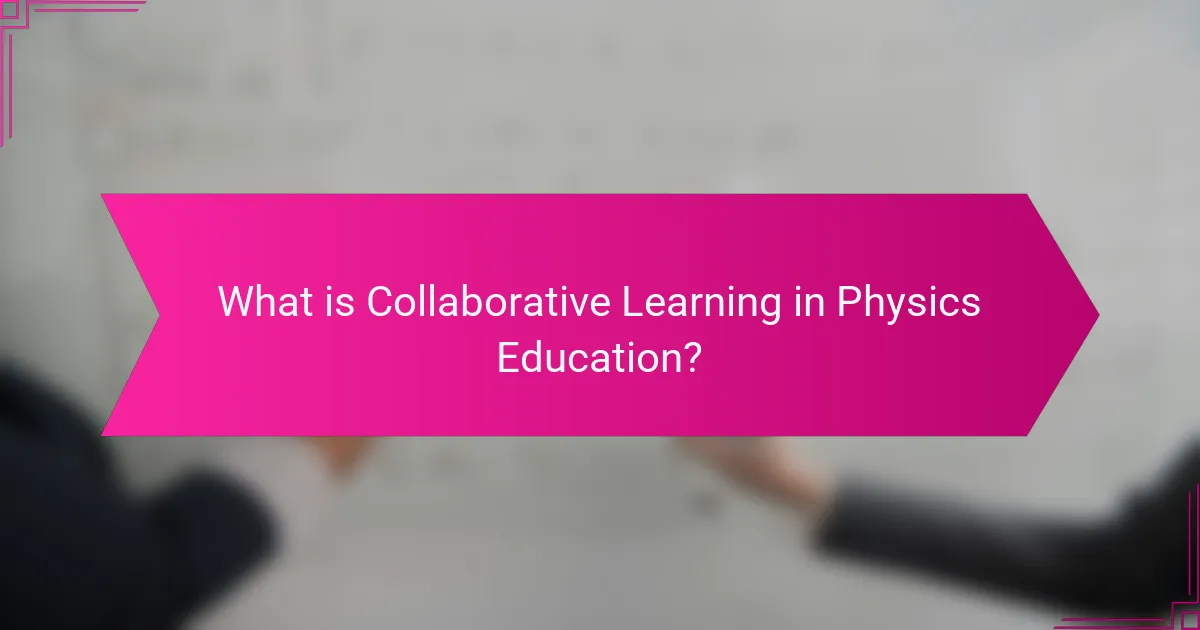
What is Collaborative Learning in Physics Education?
Collaborative learning in physics education is an instructional approach where students work together to solve problems and understand concepts. This method encourages active participation and communication among peers. It enhances critical thinking and allows students to learn from each other’s perspectives. Research shows that collaborative learning improves retention of physics concepts. A study by Johnson and Johnson (1999) found that cooperative learning strategies lead to higher achievement and greater motivation in science subjects.
How does Collaborative Learning differ from traditional learning methods?
Collaborative learning emphasizes group interaction and collective problem-solving, whereas traditional learning focuses on individual instruction and memorization. In collaborative learning, students engage in discussions and share diverse perspectives. This method fosters critical thinking and enhances communication skills. Traditional learning often involves a teacher-centered approach, where the instructor delivers content directly to students. Research indicates that collaborative learning can lead to higher retention rates and deeper understanding of material. A study by Johnson and Johnson (1999) found that students in collaborative settings performed better academically than those in traditional classrooms.
What are the key principles of Collaborative Learning in Physics?
The key principles of Collaborative Learning in Physics include active engagement, interdependence, and shared responsibility. Active engagement involves students participating in discussions and problem-solving activities. This principle enhances understanding and retention of physics concepts. Interdependence requires students to rely on one another for knowledge and skills. This fosters teamwork and communication. Shared responsibility emphasizes that all group members contribute to the learning process. Research shows that collaborative learning improves academic performance in physics. A study by Johnson, Johnson, and Smith (1998) found that students in collaborative settings perform better than those in traditional classrooms. These principles create a supportive learning environment that enhances physics education.
How does group dynamics influence learning outcomes?
Group dynamics significantly influence learning outcomes by shaping interactions among learners. Positive group dynamics foster collaboration, which enhances understanding of complex concepts. When students engage with peers, they articulate ideas and clarify misconceptions. This process leads to deeper cognitive processing and retention of information. Research indicates that collaborative learning environments improve academic performance. A study by Johnson and Johnson (1999) found that cooperative learning increases achievement and promotes positive relationships among students. Effective group dynamics also encourage motivation and accountability, which further boost learning outcomes.
What are the advantages of Collaborative Learning in Physics Education?
Collaborative learning in physics education enhances student engagement and understanding of complex concepts. It encourages active participation, allowing students to discuss and solve problems together. This method fosters critical thinking and improves communication skills among peers. Research shows that students in collaborative settings perform better on assessments. A study by Johnson et al. (2014) found that collaborative learning increases retention of material. Additionally, it promotes a sense of community, reducing feelings of isolation in students. Overall, collaborative learning creates a more dynamic and interactive learning environment in physics education.
How does it enhance student engagement and motivation?
Collaborative learning enhances student engagement and motivation by fostering active participation. It encourages students to work together toward common goals. This interaction builds a sense of community and belonging. Research shows that students involved in collaborative learning report higher motivation levels. A study by Johnson et al. (2014) found that cooperative learning strategies significantly increased student engagement in physics classes. Additionally, collaborative tasks often make learning more enjoyable. This enjoyment leads to increased intrinsic motivation. Overall, the social dynamics of collaborative learning create a more stimulating educational environment.
What impact does Collaborative Learning have on problem-solving skills?
Collaborative learning enhances problem-solving skills significantly. It fosters critical thinking by allowing students to engage with diverse perspectives. This interaction encourages deeper understanding of concepts. Research shows that students in collaborative settings perform better in problem-solving tasks. A study by Johnson & Johnson (2014) found that collaborative learning improves achievement and retention. Students learn to communicate effectively and share responsibility for outcomes. This teamwork cultivates resilience and adaptability when facing challenges. Overall, collaborative learning is a powerful tool for developing essential problem-solving skills.
In what ways does it promote deeper understanding of physics concepts?
Collaborative learning promotes deeper understanding of physics concepts by encouraging active engagement among students. It allows learners to discuss and explain concepts to peers, facilitating knowledge retention. Group problem-solving activities help students apply theoretical knowledge to practical situations. This approach fosters critical thinking and enhances conceptual clarity. Research indicates that students in collaborative settings perform better on assessments than those in traditional learning environments. A study by Johnson and Johnson (2009) highlights improved academic achievement through cooperative learning strategies. Collaborative learning also develops communication skills, enabling students to articulate their understanding effectively. Overall, it creates a supportive learning environment that enhances comprehension of complex physics topics.
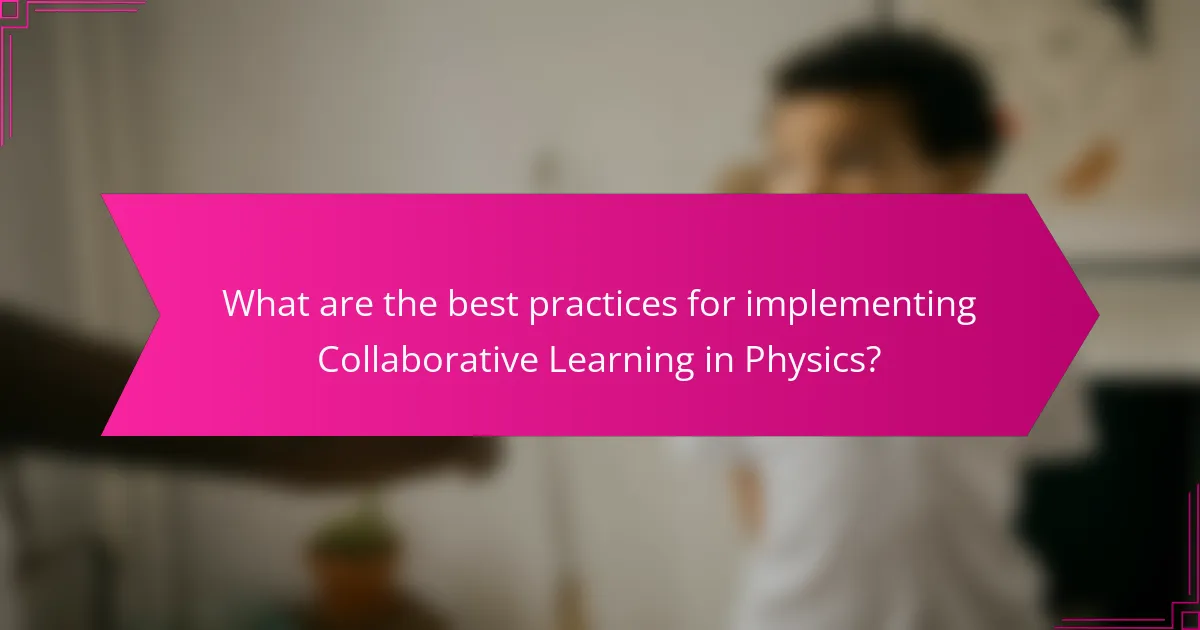
What are the best practices for implementing Collaborative Learning in Physics?
Best practices for implementing Collaborative Learning in Physics include structured group activities, clear objectives, and diverse group composition. Structured activities help students engage with complex physics concepts. Clear objectives ensure all participants understand the goals of the collaboration. Diverse group composition promotes varied perspectives and problem-solving approaches.
Regular feedback is crucial in this process. It allows students to reflect on their contributions and understand their learning progress. Incorporating technology can enhance collaboration. Tools such as online discussion forums or simulation software facilitate interaction and engagement.
Additionally, peer teaching can be highly effective. Students explaining concepts to each other reinforces their understanding. Finally, assessing both individual and group performance provides a comprehensive evaluation of learning outcomes. These practices create an effective collaborative learning environment in physics education.
How can educators effectively design Collaborative Learning activities?
Educators can effectively design Collaborative Learning activities by establishing clear objectives and roles for students. Clear objectives help students understand the purpose of the activity. Assigning specific roles fosters accountability and engagement among participants.
Incorporating diverse group compositions enhances learning experiences. Diverse groups bring varied perspectives and skills, enriching discussions. Additionally, providing structured guidelines for interaction promotes productive collaboration. Structured guidelines can include protocols for communication and conflict resolution.
Utilizing technology can facilitate collaboration, especially in remote settings. Tools like shared documents and discussion forums enable real-time collaboration. Regular reflection and feedback sessions can improve the learning process. These sessions allow students to assess their collaboration and make necessary adjustments.
Research shows that Collaborative Learning can lead to improved academic performance. A study by Johnson and Johnson (2014) found that students in collaborative settings outperformed those in traditional settings. This evidence supports the effectiveness of well-designed Collaborative Learning activities in enhancing student outcomes.
What role does group size play in Collaborative Learning effectiveness?
Group size significantly impacts the effectiveness of collaborative learning. Smaller groups often enhance communication and engagement among participants. This fosters a more intimate learning environment. Research indicates that groups of 3 to 5 members optimize participation and accountability. Larger groups can lead to social loafing, where individuals contribute less effort. A study by Johnson and Johnson (2014) found that smaller groups yield higher achievement and satisfaction levels. Thus, appropriate group size is crucial for maximizing collaborative learning outcomes.
How can technology be integrated into Collaborative Learning in Physics?
Technology can be integrated into Collaborative Learning in Physics through various tools and platforms. Online collaborative platforms like Google Docs allow students to work together in real-time. Virtual simulations enable students to explore complex physics concepts interactively. Tools such as video conferencing facilitate discussions and teamwork among students in different locations. Learning Management Systems (LMS) can organize group projects and track contributions. Interactive whiteboards can enhance group brainstorming sessions. Research shows that technology enhances engagement and understanding in physics education. A study by Hwang et al. (2019) indicates that technology integration improves collaborative learning outcomes in science subjects.
What strategies can be used to foster a collaborative environment?
Encouraging open communication is essential to foster a collaborative environment. This involves creating platforms for team members to share ideas freely. Establishing clear goals aligns the team’s efforts and enhances collaboration. Providing regular feedback helps individuals understand their contributions. Utilizing collaborative tools facilitates seamless interaction among team members. Organizing team-building activities strengthens relationships and trust. Encouraging diverse perspectives brings innovative solutions and enhances problem-solving. Training in collaboration skills equips individuals with necessary tools for effective teamwork. Implementing these strategies can significantly improve collaboration in educational settings, including physics education.
How can educators encourage positive interdependence among students?
Educators can encourage positive interdependence among students by designing collaborative learning activities that require teamwork. These activities should include clearly defined roles for each student, fostering accountability. Group projects in physics, such as experiments or problem-solving tasks, can enhance this interdependence. Educators should also implement peer feedback sessions to promote communication and support. Research indicates that structured group interactions lead to better learning outcomes. According to a study by Johnson and Johnson (1999), cooperative learning enhances student achievement and social skills.
What methods can be employed to facilitate effective communication within groups?
Methods to facilitate effective communication within groups include active listening, clear articulation of ideas, and structured discussions. Active listening involves fully concentrating on the speaker, which enhances understanding. Clear articulation of ideas ensures that messages are conveyed without ambiguity. Structured discussions, such as using agendas or time limits, promote focused dialogue.
Research indicates that these methods lead to improved group outcomes. A study published in the Journal of Educational Psychology found that groups employing active listening and structured communication achieved higher levels of collaboration and problem-solving. Therefore, implementing these methods can significantly enhance communication in group settings.
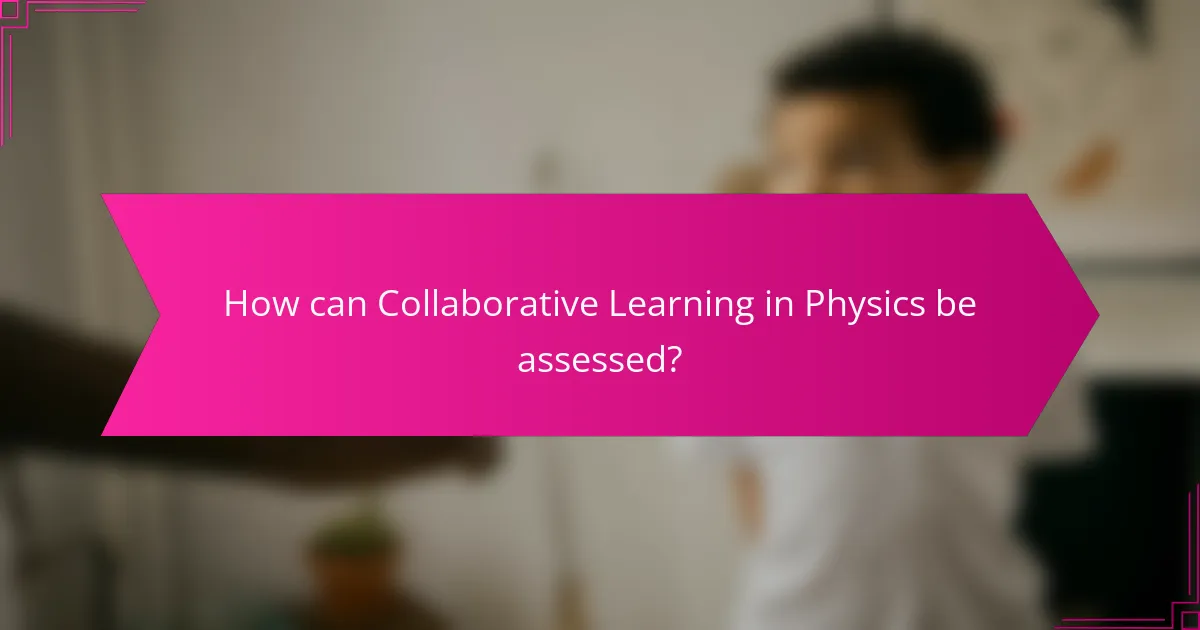
How can Collaborative Learning in Physics be assessed?
Collaborative learning in physics can be assessed through various methods. These methods include peer evaluations, group projects, and individual reflections. Peer evaluations allow students to assess each other’s contributions and teamwork skills. Group projects can be graded based on the final product and the collaborative process. Individual reflections enable students to articulate their learning experiences and contributions. Research indicates that assessment methods that include self and peer evaluations enhance accountability and engagement. A study by Johnson and Johnson (1999) found that collaborative assessment improves learning outcomes in group settings.
What assessment methods are most effective for Collaborative Learning outcomes?
Peer assessment is one of the most effective methods for evaluating collaborative learning outcomes. This method encourages students to provide feedback to each other, enhancing their understanding of the material. Additionally, it fosters critical thinking and reflection on group dynamics. Self-assessment is also valuable, as it allows learners to evaluate their contributions and learning progress. Rubrics are essential tools for both peer and self-assessment. They provide clear criteria for evaluation, ensuring consistency and fairness. Research indicates that structured peer assessments can improve student engagement and academic performance. Studies show that students who participate in peer assessment demonstrate a deeper understanding of collaborative skills.
How can peer assessment be utilized in Collaborative Learning settings?
Peer assessment can be utilized in collaborative learning settings to enhance student engagement and feedback. It allows students to evaluate each other’s work, fostering critical thinking and reflection. This process encourages active participation and accountability among peers. Research shows that peer assessment can improve learning outcomes by providing diverse perspectives. It also helps students develop assessment skills that are valuable in their academic and professional lives. In collaborative settings, peer assessment promotes a sense of community and shared responsibility for learning. It can be structured through rubrics to ensure consistency and fairness in evaluations. Overall, peer assessment is an effective tool for enriching collaborative learning experiences.
What role does self-assessment play in student learning and reflection?
Self-assessment plays a crucial role in student learning and reflection. It encourages students to evaluate their understanding and skills independently. This process fosters metacognition, allowing students to think about their thinking. Research indicates that self-assessment can enhance academic performance by promoting deeper engagement with the material. A study by Boud and Falchikov (2006) found that students who engage in self-assessment show improved learning outcomes. Additionally, self-assessment helps students identify their strengths and weaknesses. It also encourages goal-setting and personal accountability in their learning journey. Overall, self-assessment is a valuable tool for enhancing student reflection and learning.
How can educators measure the success of Collaborative Learning initiatives?
Educators can measure the success of Collaborative Learning initiatives through various assessment methods. These methods include analyzing student performance metrics, such as grades and test scores. Surveys and feedback forms can provide insights into student satisfaction and engagement levels. Observational assessments can help evaluate group interactions and collaboration skills. Peer evaluations can offer perspectives on individual contributions within groups. Additionally, tracking improvements in critical thinking and problem-solving skills can indicate the effectiveness of collaborative efforts. Research shows that structured assessments can lead to a 20% increase in student engagement in collaborative settings.
What metrics can be used to evaluate student performance in group settings?
Metrics to evaluate student performance in group settings include peer assessments, group project outcomes, and individual contributions. Peer assessments involve students evaluating each other’s participation and effectiveness within the group. Group project outcomes measure the final result of the collaborative effort, assessing both the quality of the work and adherence to project guidelines. Individual contributions track each student’s specific input and engagement in group tasks. Research indicates that these metrics provide a comprehensive view of both collaborative and individual performance. Effective evaluation can lead to improved learning outcomes and accountability among students.
How can feedback be effectively gathered from students regarding their Collaborative Learning experiences?
Feedback can be effectively gathered from students by using structured surveys and interviews. Surveys can include both quantitative and qualitative questions. Quantitative questions can measure satisfaction levels on a scale. Qualitative questions can allow students to express their thoughts in detail. Additionally, focus groups can facilitate open discussions about collaborative learning experiences. Observations during group activities can also provide insights into student interactions. Regular feedback sessions can encourage ongoing communication. Implementing anonymous feedback options can increase honesty in responses. These methods ensure a comprehensive understanding of student experiences in collaborative learning.
What are some practical tips for successful Collaborative Learning in Physics Education?
Successful Collaborative Learning in Physics Education can be achieved by implementing structured group activities. Encourage students to work in diverse teams to enhance perspective sharing. Assign specific roles within groups to promote accountability and engagement. Use real-world problems to motivate collaboration and apply theoretical concepts. Incorporate peer teaching, where students explain concepts to each other, reinforcing understanding. Provide clear guidelines and objectives for group tasks to maintain focus. Regularly assess group dynamics and individual contributions to ensure equitable participation. Foster an environment of open communication to facilitate idea exchange and conflict resolution.
Collaborative Learning in Physics Education is an instructional approach where students work together to enhance their understanding of physics concepts through active participation and communication. This article explores the advantages of collaborative learning, including improved retention, critical thinking, and motivation, while contrasting it with traditional learning methods. Key principles such as active engagement, interdependence, and shared responsibility are highlighted, alongside best practices for implementation and assessment methods like peer and self-assessment. Additionally, the impact of group dynamics and technology integration on learning outcomes is discussed, providing a comprehensive overview of effective collaborative learning strategies in physics education.
